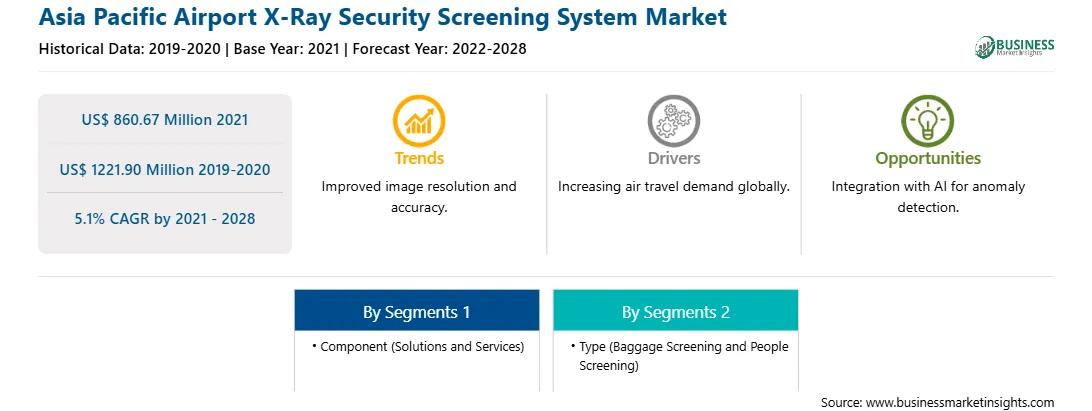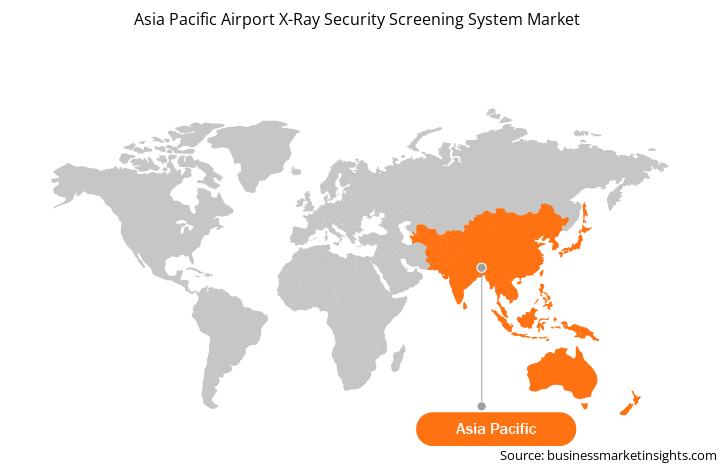Market Introduction
Security screening machines at airports operate by scanning X-ray (ionizing radiation) or high RF (radiofrequency) radiation (non‑ionizing radiation) over the passenger's body. These X-ray full-body scanners provide alternatives to the traditional method of body searching and extend the detection capabilities of existing technologies. X-ray screening machines are designed to detect weapons, explosives, and other prohibited items hidden underneath clothing. These technologies can also detect explosives that passengers carry onto civil aircraft in a liquid, aerosol, or gel form.

Market Overview and Dynamics
The Asia Pacific airport x-ray security screening system is expected to grow from US$ 860.67 million in 2021 to US$ 1221.90 million by 2028; it is estimated to register a CAGR of 5.1% from 2021 to 2028. Growing safety concerns due to increasing terrorist activities and the availability of body scanners equipped with advanced technologies are propelling the demand for airport X-ray screening systems in APAC countries. However, inadequate information and privacy concerns of airport x-ray security systems are expected to hamper the market growth.Increasing terrorist activities and rising threats to major economies have forced the governments and other governing bodies to pay attention to air traffic controls. For instance, the Airports Authority of India (AAI) is set to increase security scanning systems at various airports in the country. The deployment of full-body scanners at airports helps reduce fraudulent activities, including the smuggling of diamonds, narcotics, and weapons. The deployment of security screening systems, which include full-body scanners as the major components, can successfully deteriorate the impact of terrorist activities. In May 2021, Rohde & Schwarz supplied quick personnel security (QPS) scanners to Heathrow Airport for reducing passenger wait times and enhancing security checkpoints. The products are expected to ensure that all passengers, staff, and contractors accessing airside locations are scanned on entry. The scanners address the three key airport requirements: high accuracy of threat detection, low frequency of false alarms, and fast throughput to reduce passenger wait times even at busy periods. Similarly, in October 2021, Incheon International Airport Corporation (IIAC) awarded Smiths Detection a contract to deliver and install HI-SCAN 10080 XCT, high-speed explosives detection system (EDS), for hold baggage screening at the Incheon International Airport (ICN) Terminal 2, as part of its Phase 4 Expansion Construction Project. Likewise, in August 2021, OSI Systems, Inc. received an order valued at ~US$ 13 million to supply multiple units of RTT 110 explosive detection systems to an international airport in APAC to screen passengers’ hold baggage. Further, the maintenance and training service providers are also expected to witness significant demand for their services, as smooth solution installation requires enhanced operational and maintenance training.
The COVID-19 pandemic has resulted in delays in airport expansion projects in India. Construction work in Patna, Mumbai, and Delhi was deferred due to the rising cases of COVID-19 in the country. In addition, the Penang International Airport (Malaysia) and Singapore Changi Airport (Singapore) expansion projects were discontinued during this period. However, the uninterrupted pace of urbanization in developing countries of Asia Pacific is anticipated to offer ample growth opportunities to the Asia Pacific airport x-ray security screening system market players.
Key Market Segments
Based on component, the Asia Pacific airport x-ray security screening system market is segmented into solutions and services. The solutions segment held a larger market share in 2020 and is expected to continue its dominance throughout the forecast period with a greater revenue share.
Based on type, the Asia Pacific airport x-ray security screening system is segmented into baggage screening and people screening. The baggage screening segment dominated the airport x-ray security screening market in 2020 and is expected to further dominate the market throughout the forecast period.
Major Sources and Companies Listed
A few of the primary and secondary sources associated with this report on the Asia Pacific airport x-ray security screening system are the Center of Asia-Pacific Aviation (CAPA), Federal Aviation Administration (FAA), and International Air Transport Administration (ICAO).
Reasons to buy the report
ASIA PACIFIC AIRPORT X-RAY SECURITY SCREENING SYSTEM MARKET SEGMENTATION
Strategic insights for the Asia Pacific Airport X-Ray Security Screening System provides data-driven analysis of the industry landscape, including current trends, key players, and regional nuances. These insights offer actionable recommendations, enabling readers to differentiate themselves from competitors by identifying untapped segments or developing unique value propositions. Leveraging data analytics, these insights help industry players anticipate the market shifts, whether investors, manufacturers, or other stakeholders. A future-oriented perspective is essential, helping stakeholders anticipate market shifts and position themselves for long-term success in this dynamic region. Ultimately, effective strategic insights empower readers to make informed decisions that drive profitability and achieve their business objectives within the market.

| Report Attribute | Details |
|---|---|
| Market size in 2021 | US$ 860.67 Million |
| Market Size by 2028 | US$ 1221.90 Million |
| Global CAGR (2021 - 2028) | 5.1% |
| Historical Data | 2019-2020 |
| Forecast period | 2022-2028 |
| Segments Covered |
By Component
|
| Regions and Countries Covered | Asia-Pacific
|
| Market leaders and key company profiles |
The geographic scope of the Asia Pacific Airport X-Ray Security Screening System refers to the specific areas in which a business operates and competes. Understanding local distinctions, such as diverse consumer preferences (e.g., demand for specific plug types or battery backup durations), varying economic conditions, and regulatory environments, is crucial for tailoring strategies to specific markets. Businesses can expand their reach by identifying underserved areas or adapting their offerings to meet local demands. A clear market focus allows for more effective resource allocation, targeted marketing campaigns, and better positioning against local competitors, ultimately driving growth in those targeted areas.

The Asia Pacific Airport X-Ray Security Screening System Market is valued at US$ 860.67 Million in 2021, it is projected to reach US$ 1221.90 Million by 2028.
As per our report Asia Pacific Airport X-Ray Security Screening System Market, the market size is valued at US$ 860.67 Million in 2021, projecting it to reach US$ 1221.90 Million by 2028. This translates to a CAGR of approximately 5.1% during the forecast period.
The Asia Pacific Airport X-Ray Security Screening System Market report typically cover these key segments-
The historic period, base year, and forecast period can vary slightly depending on the specific market research report. However, for the Asia Pacific Airport X-Ray Security Screening System Market report:
The Asia Pacific Airport X-Ray Security Screening System Market is populated by several key players, each contributing to its growth and innovation. Some of the major players include:
The Asia Pacific Airport X-Ray Security Screening System Market report is valuable for diverse stakeholders, including:
Essentially, anyone involved in or considering involvement in the Asia Pacific Airport X-Ray Security Screening System Market value chain can benefit from the information contained in a comprehensive market report.